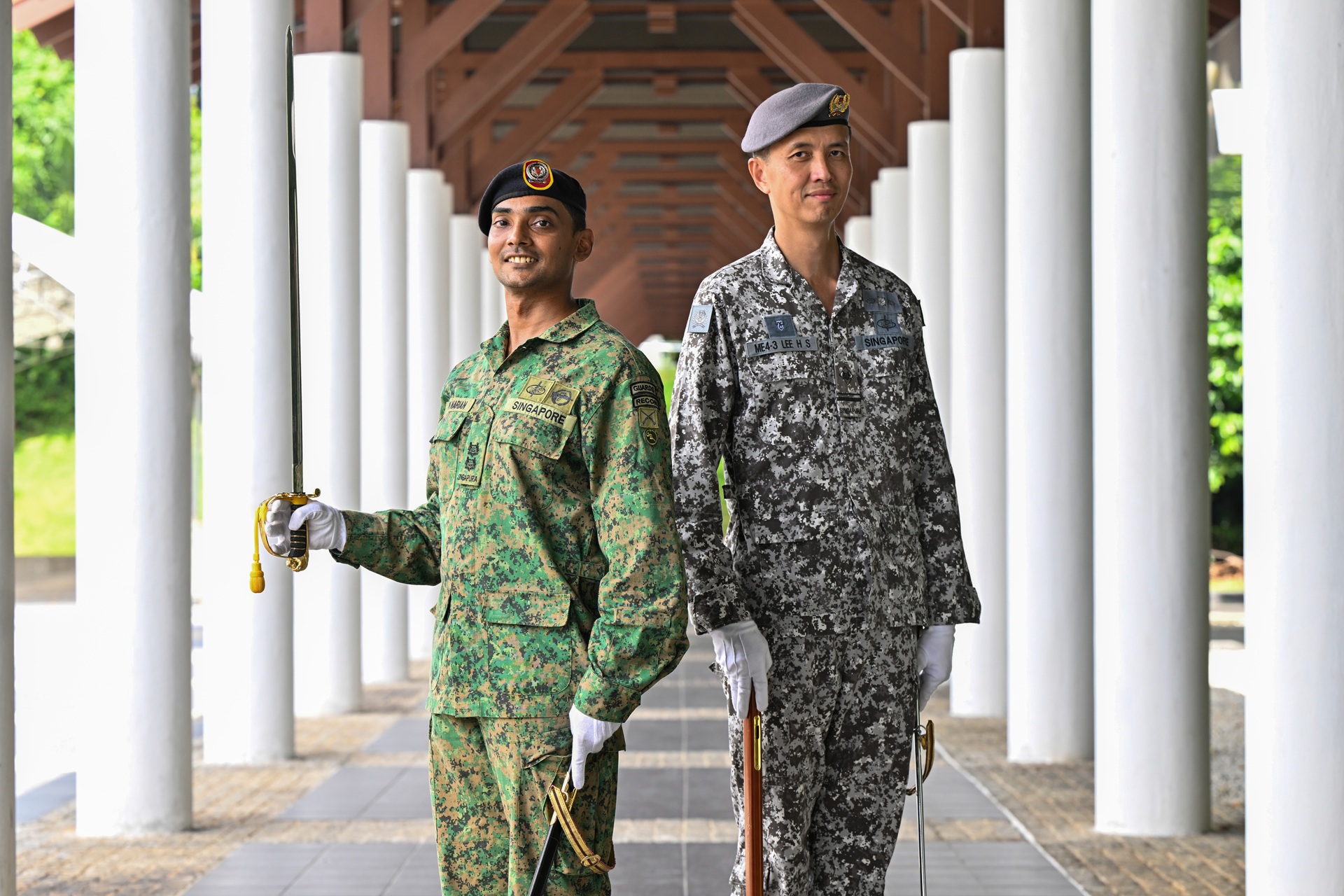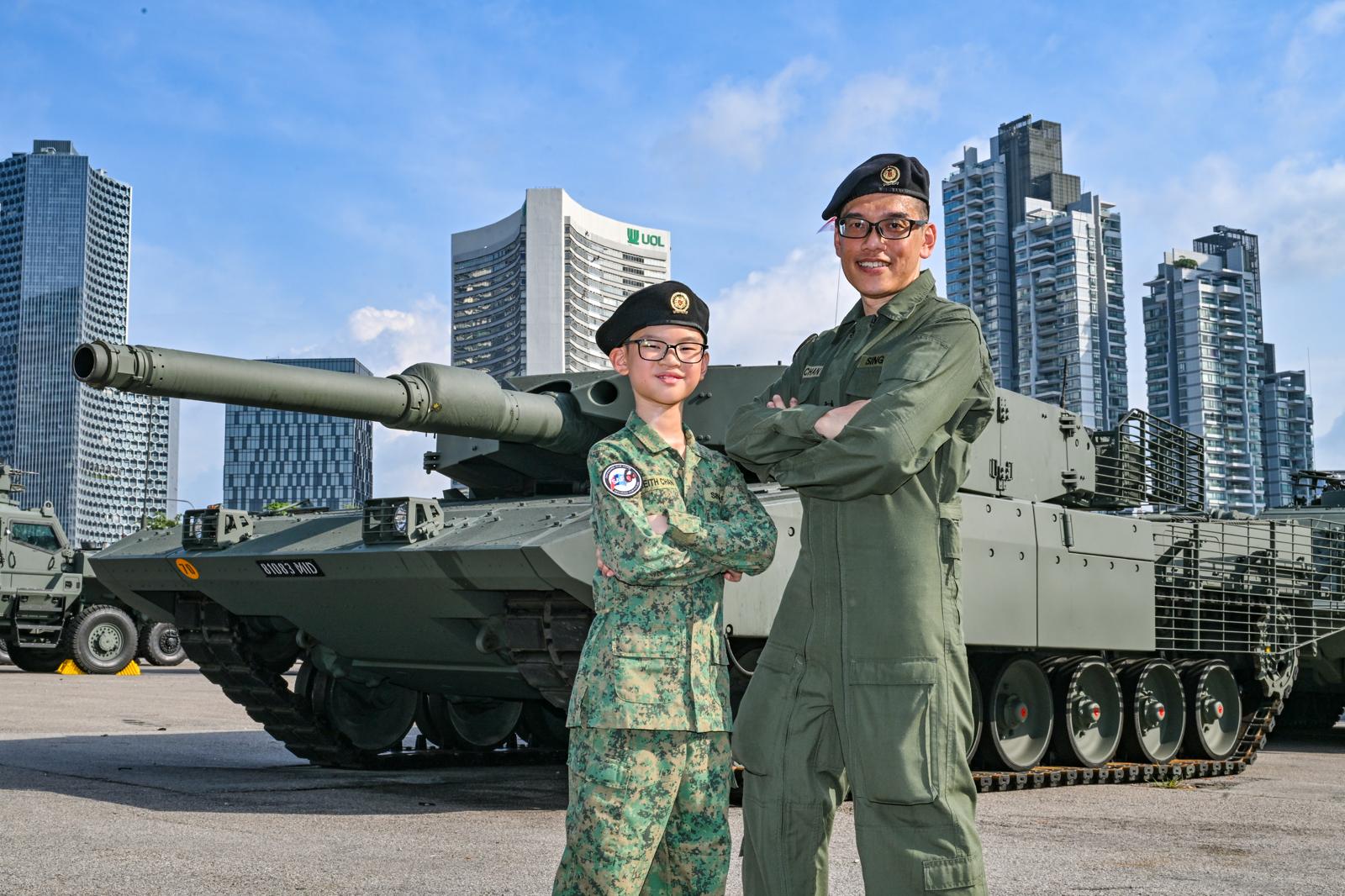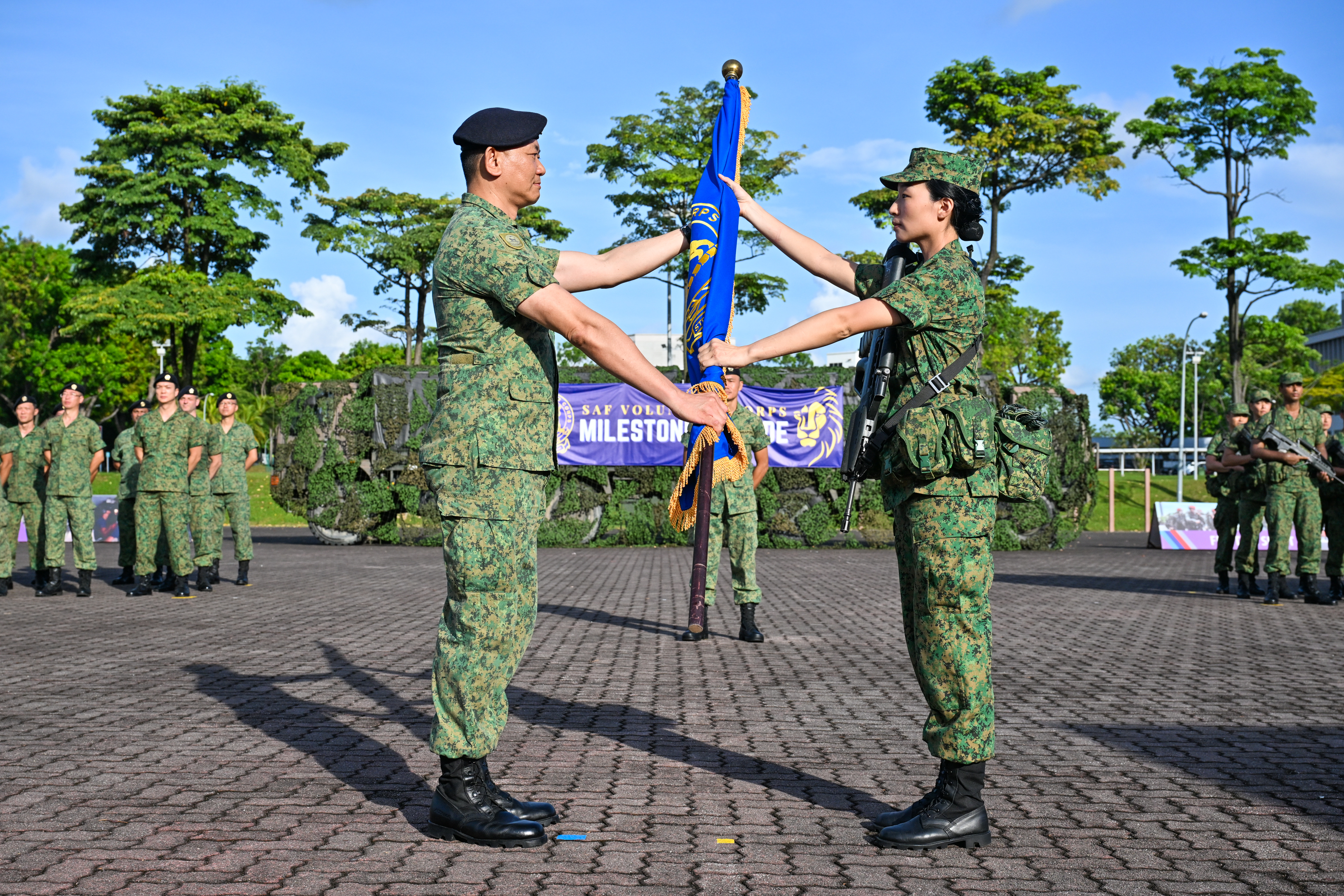FOR A SAFE SINGAPORE
PHOTO // PIONEER Photographers & Courtesy of Stefan Tan
Miles away in the distant country of Afghanistan, a five-man team of Military Institutional Trainers (MITs) from the SAF and their Australian counterparts are now training Afghan National Army (ANA) commanders in Oruzgan, Afghanistan. Another 10-man team is deployed in an Australian Defence Force-sponsored artillery school in Kabul, Afghanistan.
Military Expert (ME) 3 R. Arivalagan, who was part of a team deployed in Kabul for five months last year, recounted how the danger of being caught in a fire fight was always present, but he also understood that he had a job to do there. "The ANA is just starting up and they need the expertise to be able to protect their own country."
He added: "[Looking back,] I have become more aware of the security threats we may face in Singapore. I came back a better soldier, feeling even more ready to do my part to defend the country."
In a world where security threats are becoming increasingly complex and multi-faceted, safeguarding the security of the country and its interests has meant undertaking missions beyond Singapore' borders as events which take place far away can translate to security issues in the region. To do that, the SAF has steadily built up its capabilities, cultivated regional ties and participated in international security operations.
"While our contributions are typically not large in scale, they represent niche capabilities that are significant for the overall coalition effort. We look at places that we can specifically help and contribute towards the success of a multinational mission,"said Minister for Defence Dr Ng Eng Hen at an Overseas Service Medal presentation ceremony last year.
"If someone suggested 10 to 15 years ago that Singapore would send assets and troops to Afghanistan it would have been dubbed a fantasy, but here we are with a number of rotations to Afghanistan [and the] Gulf of Aden, as many other countries are," said Dr Ng during an interview with international defence publication Jane's Defence Weekly.
Networked security
The reality of today's complex security landscape is that no nation or community, no matter how well equipped, can effectively handle security issues alone. A concerted effort to build and maintain a strong security architecture both regionally and globally has become crucial to maintaining peace.
The Ministry of Defence (MINDEF) thus plays an active role in groupings such as the ASEAN Defence Ministers' Meeting (ADMM) and ADMM-Plus, the Shangri-La Dialogue and the Five Power Defence Arrangements (FPDA). These platforms contribute to the regional security architecture by providing opportunities for dialogue and multilateral exercises among countries in the region and beyond.
Under the ambit of ADMM-Plus, five Expert Working Groups (EWG) were established in April last year to enhance military-to-military cooperation in humanitarian assistance and disaster relief, maritime security, counter-terrorism, military medicine and peacekeeping operations. All five EWGs have since convened and are looking to move into more challenging areas of cooperation such as joint exercises and training.
The Shangri-La Dialogue, too, has grown since it started in 2002. From 16 ministerial-level representatives from 22 countries at the inaugural meeting, participation has risen to 31 ministerial-level delegates from 30 countries in 2011. Held annually in Singapore, the 11th edition of the Dialogue will take place in June this year.
"Through the ASEAN-centric regional security architecture, we are building confidence by facilitating robust bilateral and multilateral partnerships," said Dr Ng during his speech at the Shangri-La Dialogue in 2011.
The FPDA commemorated its 40th anniversary last year. At the 8th FPDA Defence Ministers' Meeting in Singapore to mark the milestone, the ministers reaffirmed their commitment to improving cooperation, interoperability and people-to-people interactions through multilateral exercises.
From 17 Oct to 4 Nov last year, about 4,000 personnel, 68 aircraft, 18 ships, two submarines and various support elements from the FPDA member nations took part in a large-scale joint exercise codenamed Bersama Lima.
Advanced capabilities
To adequately meet evolving security challenges, the SAF has been fine-tuning its arsenal, gradually adding several new capabilities and assets as part of the planned transformation journey towards the 3rd Generation fighting force.
Last year saw the commissioning of the first Archer-class submarine, the RSS Archer, which is a significant boost to Singapore's submarine capability. The Republic of Singapore Air Force (RSAF) also took full delivery of the Gulfstream 550 Airborne Early Warning (G550-AEW) aircraft last year.
In May last year, the Army added the first fully-operational motorised infantry battalion to its ranks. Trained to operate with the Terrex Infantry Carrier Vehicle (ICV), soldiers of the 2nd Battalion, Singapore Infantry Regiment (2 SIR) now have increased mobility, firepower and protection. In addition, the Terrex ICV connects ground troops via the Battlefield Management System to other SAF platforms.
"The strength of the 3rd Generation SAF lies not just in its individual pieces of hardware, but its ability to network an array of systems and capabilities," said Dr Ng during his speech at the parade which marked the operationalisation of 2 SIR as the SAF's first motorised infantry battalion.
"Such a network allows the SAF to create an overall fighting system that is flexible and more responsive to the complex demands of the modern battlefield," he added.
One of the largest and most complex training exercises ever conducted by the SAF also took place last year in the United States (US). Exercise Forging Sabre 2011 involved all four RSAF training detachments in the US and saw more than 450 SAF airmen and soldiers as well as 25 RSAF aircraft engage in a practice run of its networked force capabilities.
The 11-day exercise culminated in an integrated live firing on 9 Dec 2011 witnessed by Chief of Air Force Major-General (MG) Ng Chee Meng and other senior SAF officers.
"I saw for myself how our airmen and soldiers worked to bring together a sophisticated suite of both sensors and shooters, like our F-15SGs, F-16C/Ds and Apaches, to effect an integrated strike against a variety of targets, including mobile targets. This in itself is a very complex operation and I think they have done very well," said MG Ng after he viewed the live firing.
On the sea front, the new National Maritime Security System (NMSS) was validated during Exercise Northstar in November last year. The NMSS analyses maritime threats and coordinates and executes plans across various national agencies.
"The NMSS provides us with a 24/7 real-time threat evaluation, so that we can get the early warning we need to deal with any impending threat. With these cues, we are then able to mount unified operations that will harness the collective strength of all maritime agencies," said Chief of Staff - Naval Staff of the Republic of Singapore Navy (RSN) Rear-Admiral Tan Wee Beng.
"The strength of the 3rd Generation SAF lies not just in its individual pieces of hardware, but its ability to network an array of systems and capabilities."
- Dr Ng on the importance of the SAF's networked capabilities
Safe seas
Singapore sits along some of the busiest sea lanes of communication in the world, with the Strait of Malacca to the west and the South China Sea to the east. As a maritime nation and a responsible member of the international community, Singapore naturally plays its part in tackling the scourge of piracy on the high seas, both at home and abroad.
The SAF has regularly sent troops to the Gulf of Aden to assist in the multinational counter-piracy operations there under the ambit of the Combined Task Force (CTF) 151. Last year, the SAF took command of CTF 151 for the second time, and deployed an SAF Task Force, comprising a Landing Ship Tank with two Super Puma helicopters on board, for the third time. The SAF also deployed a Fokker-50 Maritime Patrol Aircraft to the region in 2011 for the first time.
Speaking to the sailors of RSS Endeavour while the ship was deployed to the Gulf of Aden, Minister of State for Defence and Education Lawrence Wong said: "Your actions will ultimately contribute to the safety, security and sovereignty of Singapore, and that's a high calling and a meaningful task."
Closer to home, the SAF is actively contributing to security in the Straits of Malacca and Singapore by enhancing information sharing and conducting patrols together with Malaysia, Thailand and Indonesia under the joint Malacca Strait Patrol initiative.
Since its establishment in 2009, the RSN's Information Fusion Centre (IFC) has emerged as a key maritime information-sharing hub. Linked to 45 agencies from 28 countries, the IFC currently has 30 liaison officers from 12 countries working to provide a complete situational picture of the seas in the region, round-the-clock.
Rendered help
Though safeguarding Singapore's peace and security remains the SAF's core purpose, it is also ready to lend a hand in times of crisis by contributing to regional Humanitarian Assistance and Disaster Relief (HADR) operations.
In the aftermath of a 6.3-magnitude earthquake which struck the city of Christchurch, New Zealand, in February last year, the SAF moved quickly to provide aid, diverting its 116 troops who were already in the country for an exercise to assist in the relief efforts there.
In addition, the RSAF deployed two C-130 and a KC-135R aircraft to airlift relief supplies and evacuate civilians from the disaster areas. Over 160 civilians were evacuated over the 14 flights conducted.
Similarly, in response to the flood relief efforts in Thailand last year, the SAF deployed a C-130 and a KC-135R to move relief supplies to the stricken areas. Forty-five motorised boats were also donated to the Royal Thai Army.
In Afghanistan, the SAF continues to contribute to the ongoing rebuilding efforts there. Since 2007, the SAF has deployed more than 350 servicemen and women to the country, as well as various assets in support of the ongoing multinational efforts to stabilise the war-torn country.
The SAF has deployed Weapon Locating Radars to provide early warning against indirect-fire attacks on the Multinational Base in Tarin Kowt, Afghanistan. In addition, the SAF has also deployed an Imagery Analysis Team to provide imagery interpretation and analysis support for the multinational troops operating there.
"Hearing their stories of how war has affected them served as a constant reminder of the realities of war. This brought home the message that threats to our way of life are real and the only way to prevent that is to maintain the defence of our country," said Major (Dr) Soh Teck Hwee who was deployed to Afghanistan as part of a 13-man medical team to provide medical support and health care for International Security Assistance Force personnel and Afghan locals.
"I have become more aware of the security threats we may face in Singapore. I came back a better soldier, feeling even more ready to do my part to defend the country."
- ME3 Arivalagan on what he has learnt from his deployment in Afghanistan
Nurturing the best
Though sophisticated capabilities and good training opportunities are an important component of the SAF's operational successes, they tell only one side of the story. At its core, the quality of people - both Regulars and National Servicemen - within the SAF continue to drive its progress.
During a specialist cadet graduation parade last year, Senior Parliamentary Secretary for Defence and National Development Dr Mohamad Maliki Bin Osman said: "In an increasingly complex battlefield, every soldier must be constantly aware of his environment, and must know how to translate that knowledge into usable intelligence that will assist leaders up the chain of command and help us to prevail in battle."
The servicemen of today are a different breed from their forebears - more educated and tech-savvy individuals who are used to learning at their own pace.
Recognising this, the SAF is currently looking into fine-tuning its training methods to promote self-directed and team-based learning. One of these initiatives is the LEARNet system currently in use at various SAF training schools which allows servicemen and women to train at their own time and pace.
"This system also contains new applications that provide timely feedback and allow servicemen to better capture lessons learnt," explained Brigadier-General (BG) Lee Shiang Long, Head Joint Communications and Information Systems Department (JCISD).
"As part of the SAF's 3rd Generation transformation, we are constantly looking for innovative means to be more operationally effective through organisational learning and knowledge management," BG Lee added.
To complete the picture, SAF Regulars, too, have increased opportunities to ramp up their professional knowledge through collaborations with institutes of higher learning such as local polytechnics.
For example, the SAF has worked with Nanyang Polytechnic to offer a Certificate in Business Management for Warrant Officers, Specialists and Military Experts to pursue a Diploma in this field.
Coupled with other initiatives such as the Military Domain Experts Scheme (MDES) which allows personnel to develop specialised skills and knowledge in their chosen field, these changes point to the SAF's commitment to making continual improvements in the training and nurturing of its men and women.
"(LEARNet) also contains new applications that provide timely feedback and allow servicemen to better capture lessons learnt... We are constantly looking for innovative means to be more operationally effective through organisational learning and knowledge management."
- BG Lee on the benefits of the self-paced learning system
Citizen soldiers
As a small nation with a similarly small population, the duty of defence falls on the shoulders of able-bodied male citizens who have to serve a mandatory two-year National Service (NS) period.
While it is the only way in which Singapore can build a sizeable defence force, the SAF recognises that NS comes with sacrifice on the part of the servicemen and their families, both during the two years of full-time NS and subsequent duties as Operationally Ready National Servicemen (NSmen).
To that end, the SAF has introduced policies which give NSmen more flexibility in meeting their annual Individual Physical Proficiency Test (IPPT) requirements. Under the revised IPPT system, NSmen who fail to pass their annual physical fitness test can better schedule their Remedial Training sessions within a stipulated three-month period instead of the fixed sessions over a two-month period. NSmen looking for more help to pass their IPPT can also sign up for flexible IPPT Preparatory Training (IPT) sessions over a period of nine months, as compared to five months previously.
This year also marks the 45th year of NS. Over the years, it has become a rite of passage for all able-bodied Singaporean males and an institution of life in Singapore. Most of the full-time National Servicemen serving today will have fathers who also experienced NS, hence the theme NS: From Fathers to Sons for the upcoming celebrations.
Fully committed
SAF units have been actively engaging the various schools in Singapore, organising visits to training sites such as the Murai Urban Training Facility. Last year, the Armour formation took their Bionix Infantry Fighting Vehicles and a Bronco ambulance to National Junior College (NJC), drawing a crowd of 1,800 students and teachers.
In addition, National Education-related competition series such as the ciNE65 short film competition, which debuted in 2011, and the annual animation competition - named N.E.mation! - for Singapore school students, all contribute to building a unique national identity by giving Singaporeans platforms to share their ideas about Total Defence.
To drive home the importance of defence, MINDEF is also constantly exploring new ways of reaching out to Singaporeans. In cyberspace, the ministry is well-represented on major social networking platforms such as Facebook and Twitter, as well as popular video-sharing site YouTube.
Following the success of the reality-style Every Singaporean Son series on YouTube in 2010, MINDEF has gone on to put out various other short video series such as I am a Soldier, Sailor, Airman and Making the Cut which have also been well received.
Always ready
Even as the SAF continues to evolve its policies to meet the ever-changing security landscape and corresponding operational needs, its core mission remains the defence of Singapore.
By honing its capabilities, staying engaged with the world and nurturing its people, the SAF stands in good stead to squarely meet future challenges.
As LG Neo said during his visit to standby units over the New Year period: "It is this consistent level of security that we have which makes everyone confident and proud. The whole nation can rest well throughout the year and particularly during the holiday season because of you.
"Some of the things we do are onerous...they are tough, but there is a reason why we have to do them."
"It is this consistent level of security which makes everyone confident and proud. The whole nation can rest well throughout the year because of you. Some of the things we do are onerous...they are tough, but there is a reason why we have to do them."
- LG Neo on the need for the SAF to remain vigilant and ready
Themed NS: From Fathers to Sons, the NS45 campaign will pay tribute to the generations of National Servicemen and their families through various events throughout the year.
Do not be too alarmed if you see military hardware in the heart of the city come May, as the Army Open House (AOH) 2012 rolls into the grounds of the F1 pit building. On top of it being the first time the event will be held in the city, a roving NS showcase will also make its rounds in the heartlands after the AOH 2012. So mark your calendars for May!
Homebodies, too, can participate via the NS45 website where Singaporeans can share their stories of NS. These stories will be shared with other Singaporeans at NS45-related events, and sealed in an electronic time capsule later this year.
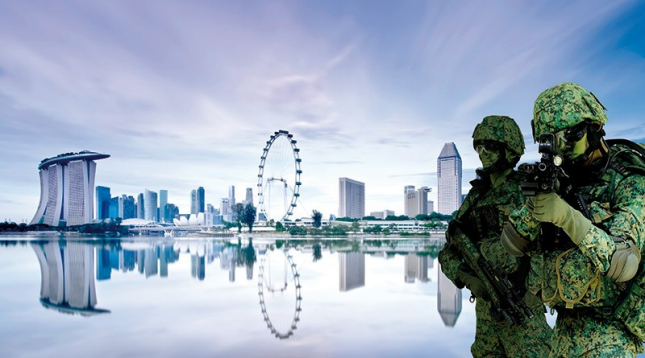
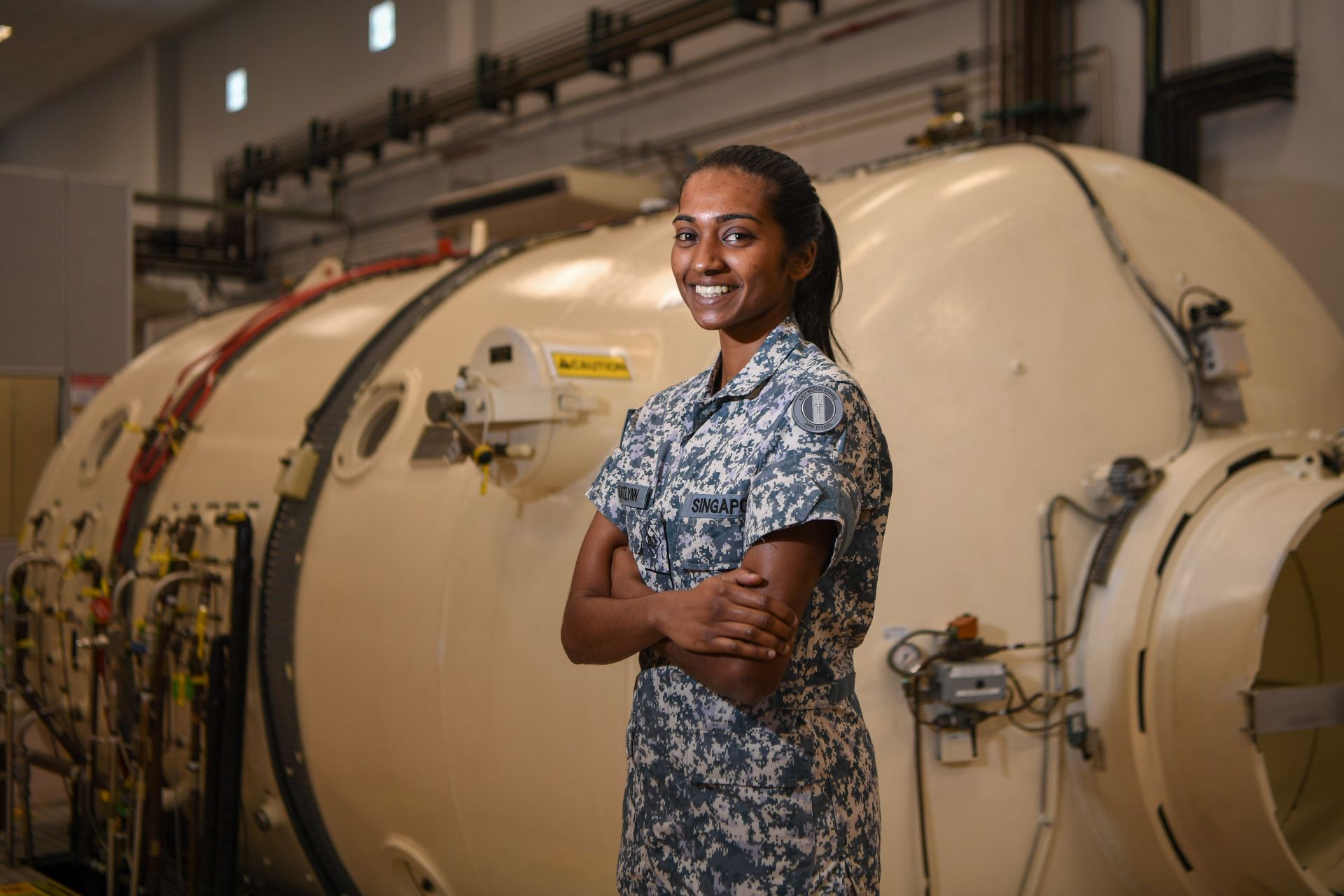
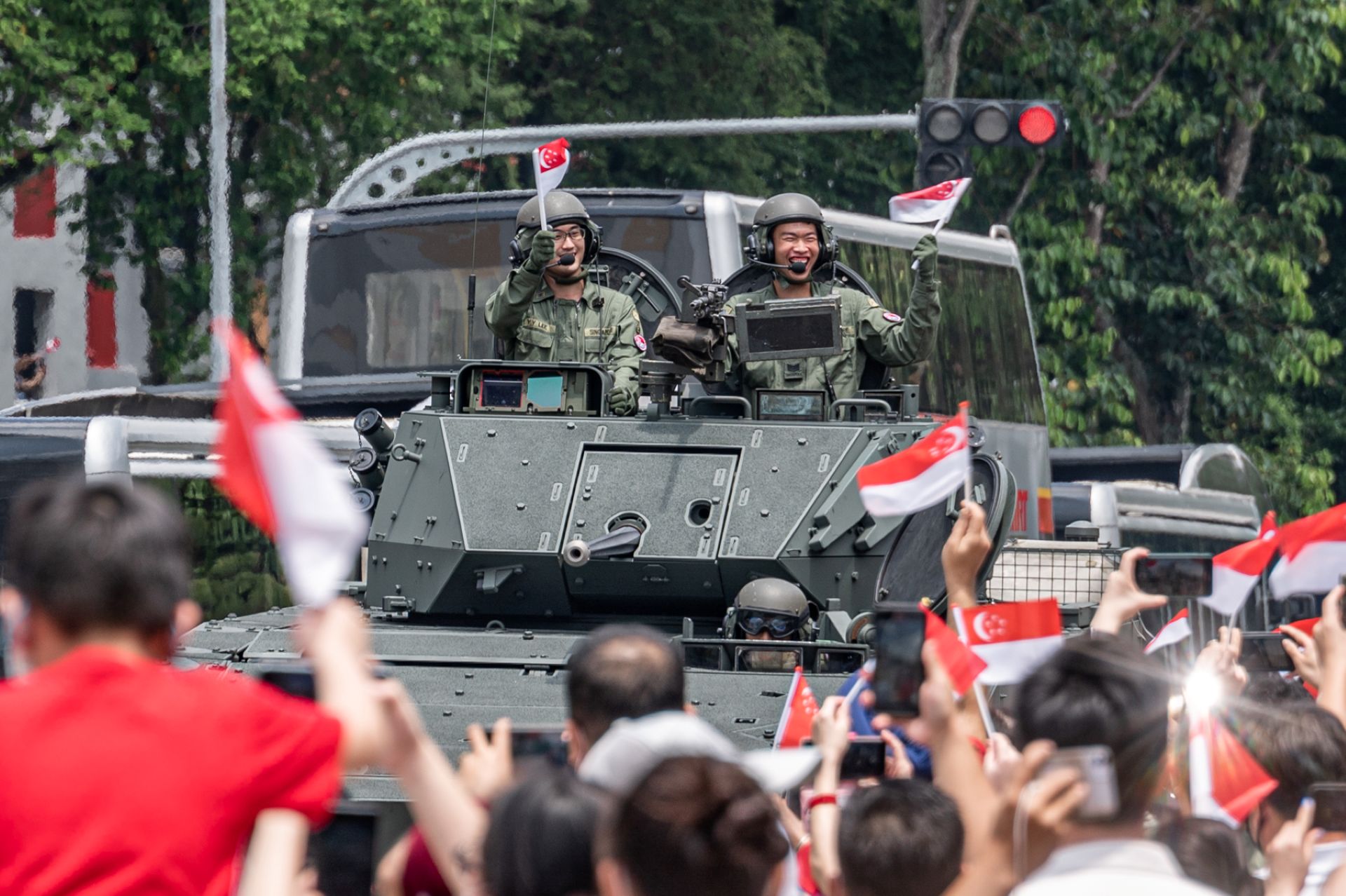
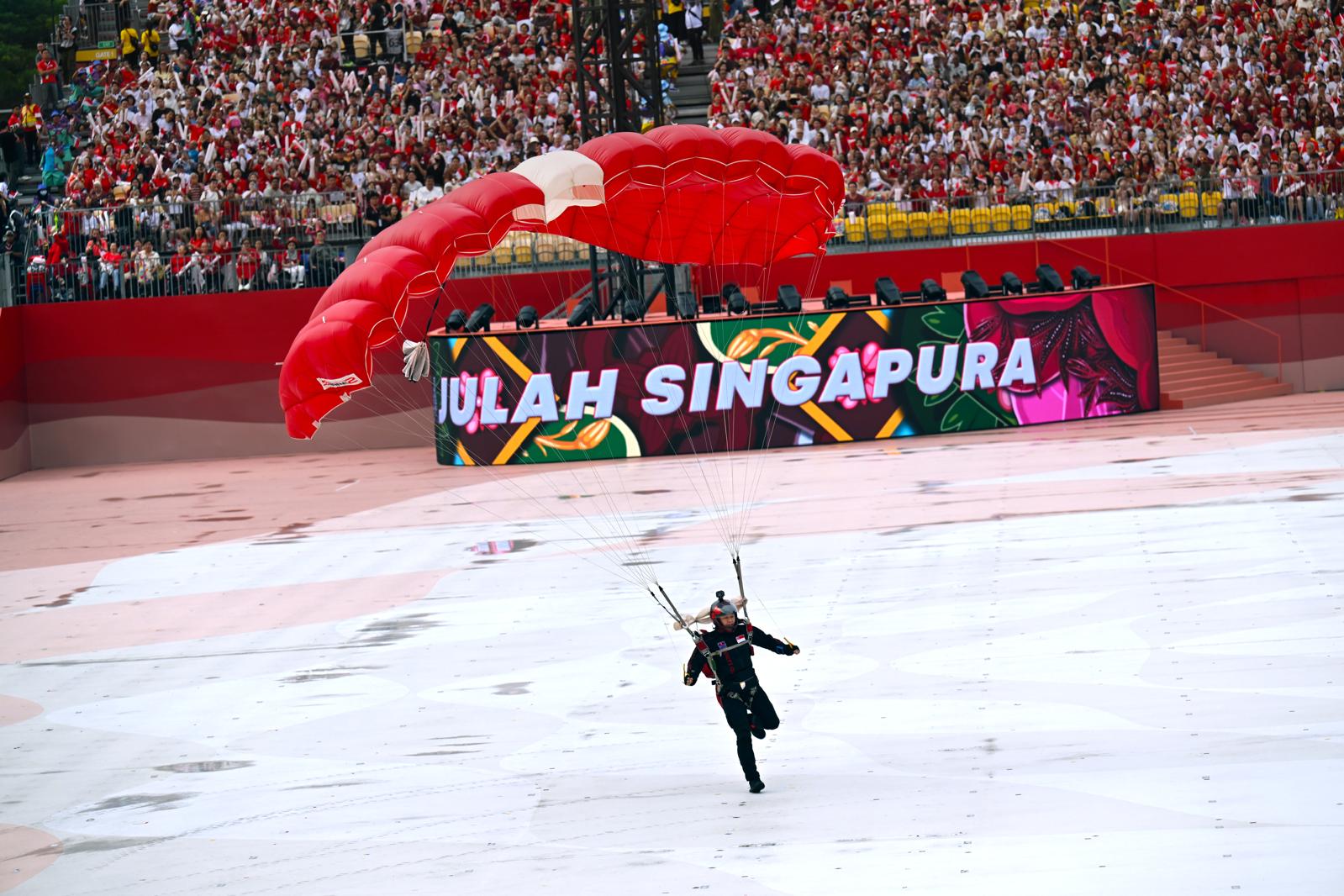
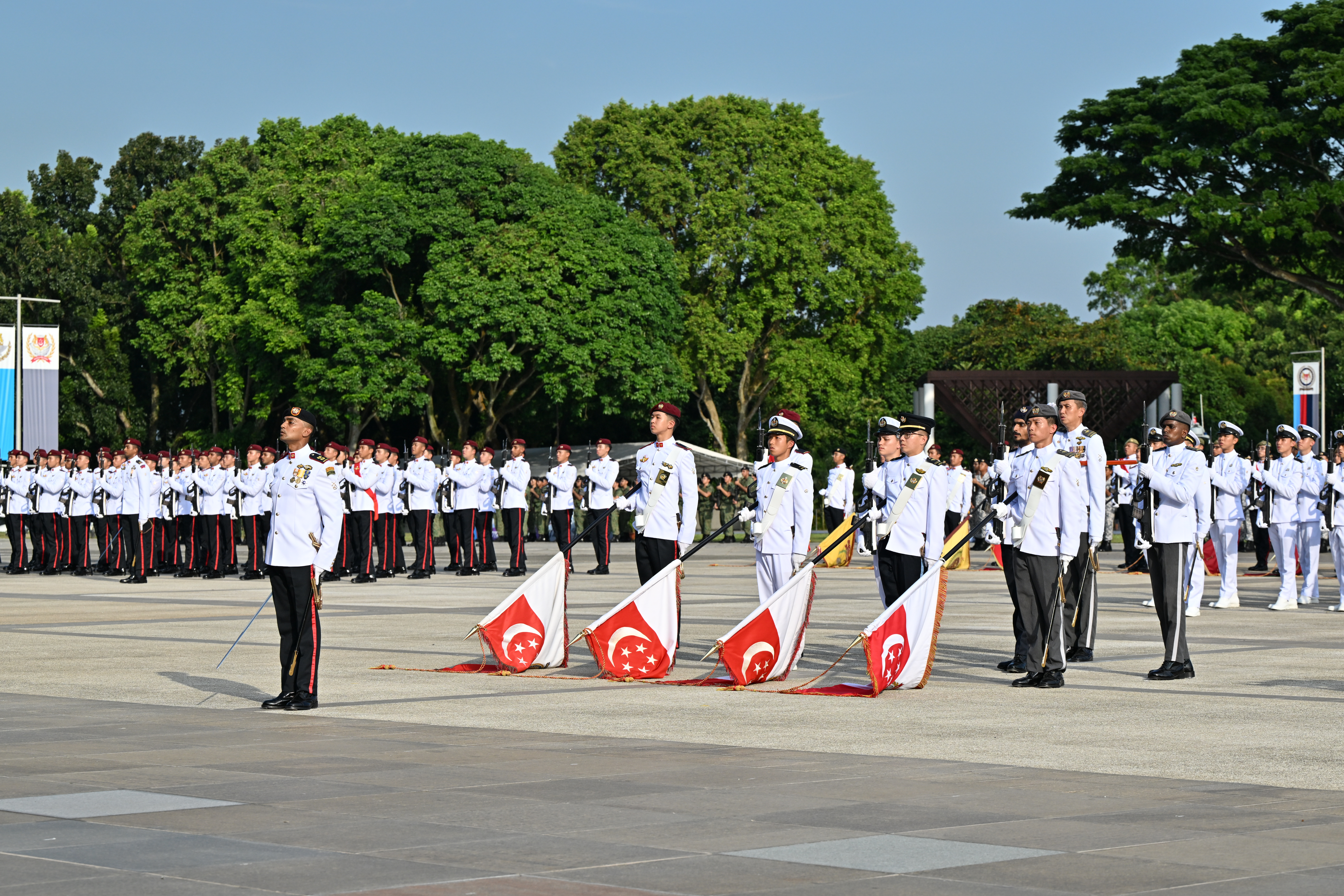
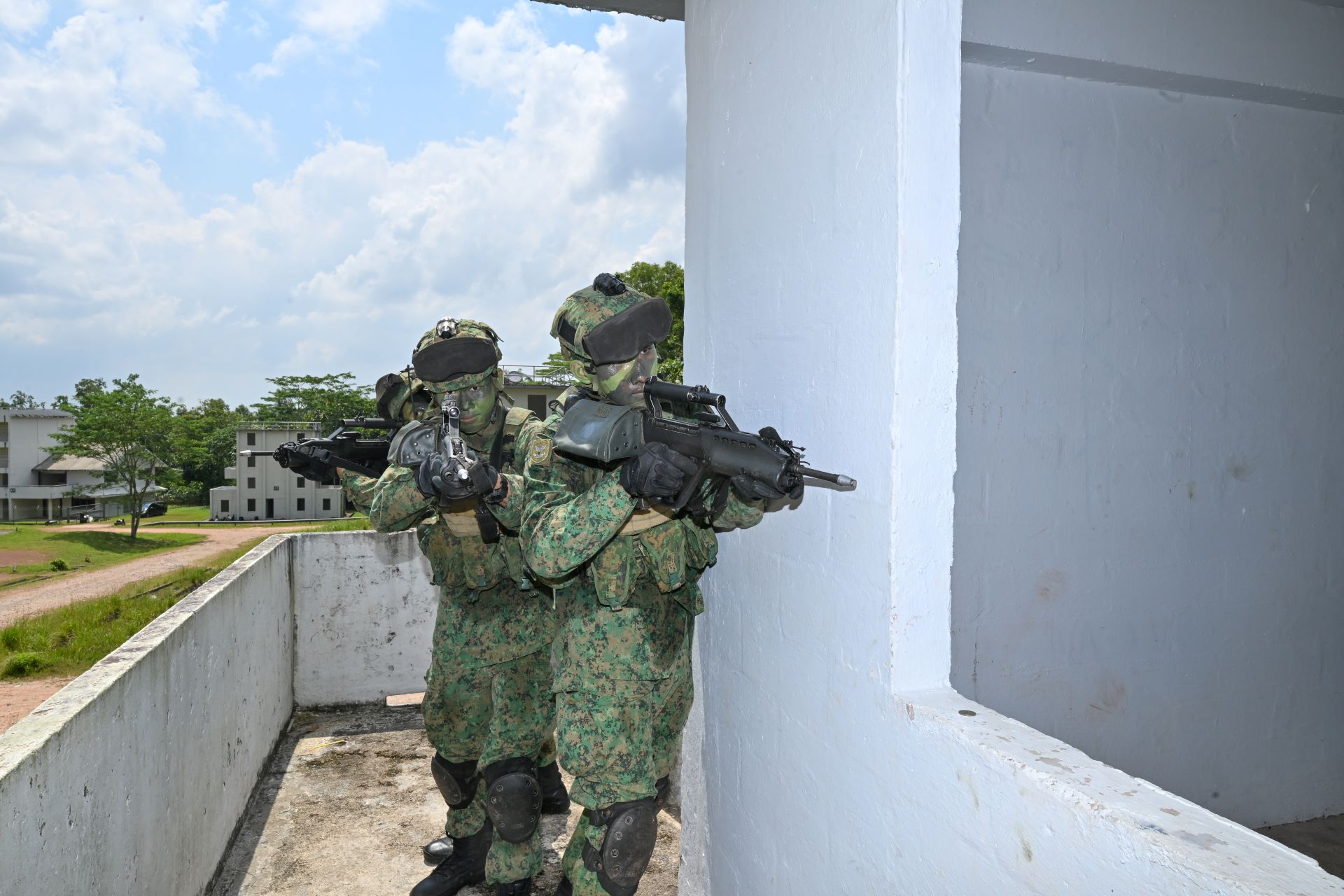
.jpg?sfvrsn=b5383902_1)
.jpg?sfvrsn=4eb1b86e_1)
